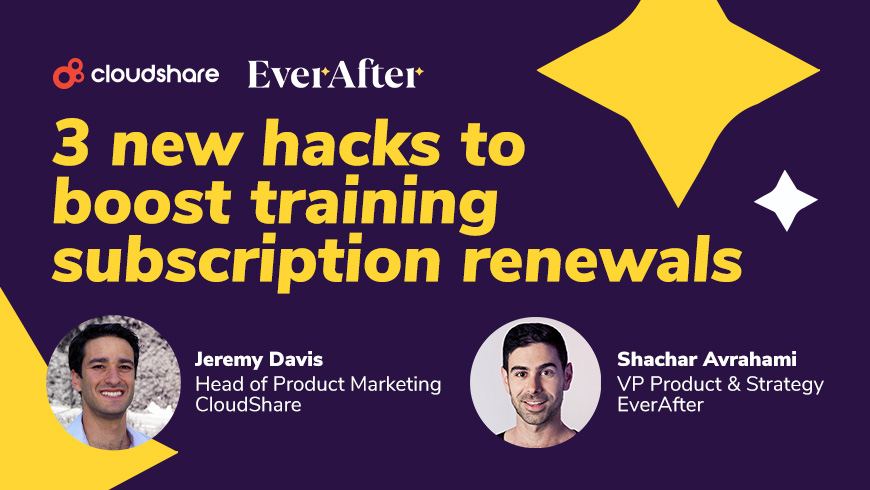
How often have you thought that your training program was the only reason customers were succeeding with your product, only to find out a year later that they barely used the program?
It’s one of the reasons why training teams struggle to maintain their revenue stream with self-renewing training subscriptions. They’re unable to monitor training usage, resulting in a lack of insight into why customers are not using their training bundles.
What’s worse is that with time, if there’s no training, product adoption dwindles. And if product adoption dwindles, your customers eventually abandon usage altogether. You get the gist.
There are several reasons why customers resort to this:
- They don’t see the ROI of a training bundle
- They don’t understand the value of training
- They don’t have the budget for training
- Their training champion has left the organization
- You don’t know how to market the training bundle
Fortunately, there are many tactics that training professionals can adopt from customer success teams to sell self-renewing on auto-pilot.
In our recent webinar, Shachar Avrahami, VP of Product and Strategy at EverAfter, shared his go-to tactics to resolve this challenge.
Using his experience in customer success and revenue operations, he shared his insights on three renewal strategies that can help companies increase revenue through training subscriptions.
Curious? Let’s dive in.
1. Customize your onboarding program and focus on value creation
What we call onboarding in the customer success world is actually the introductory lesson in the training world. Here, we introduce the students (your customers) to the program and give them a refresher on what to expect.
Your onboarding program is the first touchpoint for customer success teams post-purchase. So, create a personalized onboarding plan that focuses on the customer’s pain points—instead of a generic one.
According to Shachar, the potential for successful training renewals starts right from when they sign the contract. The idea is to create an impressionable experience that shows the customer that you truly understand their struggles and can cater to their needs.
When you invest the time and resources to do so, you’re also setting the course for a successful customer relationship.
In addition, he also recommends resolving technical issues offline. By that, he means that the customer should complete processes like integrating your CRM before they start onboarding. You can do this by sending a training manual so that they feel empowered during the process.
Value creation starts at the get-go, and in turn, your customers will feel eager to complete the onboarding tour instead of dropping off before completion. Plus, there’s a strong correlation between successful onboarding between the first 90 days and a successful renewal at the end of the year.
Focus on offering a stellar experience here—which should show the customer how valuable training programs are. Once they see how the onboarding program helped them achieve initial product adoption, they’ll realize the value of ongoing client training.
2. Track the right training KPIs and prove clear ROI
Apart from your ICP, you’re always selling to another individual in the company—the Chief Financial Officer (CFO). Every minor budget decision is passed via the finance department, as that’s where the buck stops.
To ensure that even the CFO offers a resounding yes to your software training contract, you need to prove the ROI of your training bundle. Unless you do so, it’s unclear why any company should invest in your product.
You need a solid business case with hard data to provide proof of concept in the context of the customer’s business problems. You can achieve this by tracking the right training KPIs and presenting that at the time of renewal. For example use a solution like CloudShare that helps you track such metrics. Show them how much time they saved, the level of engagement with the product, how much money they saved, etc.
The key is identifying relevant metrics and regularly reviewing them—ideally each quarter. Another way to offer a better customer experience is by using this dataset to determine where you’re not meeting their training needs—and rectifying that.
For instance, if customers are struggling with a particular feature, include extensive training sessions on it. Or else they’ll abandon your product for a simpler alternative.
You can ensure subscription renewals are instantly approved by providing detailed ROI reports associated with each training bundle.
3. Your trainees are your champions—make them shine
Every company should invest time and resources to build relationships with those who can internally champion your product. Shachar says, “You need to form an actual relationship because if you have a true relationship with your champions, then you have a really, really good sense of any renewal challenges.”
People seek recognition. An easy way to give them that is by focusing on their progress and success with the product. For example, offer to do a case study with them.
You also need to build relationships with multiple stakeholders in the company. What are you going to do when your one champion leaves the organization? You’re back to square one after all the effort you put in.
Avoid this situation by focusing on multiple champions. This ensures that you have additional internal stakeholders to continue the contract and can identify opportunities to cross-sell and upsell down the line.
Treat your training bundle like a product. Just like you’d maintain relationships with internal champions to drive product adoption, do the same to drive training adoption too.
Increase revenue through self-renewing subscriptions
As you can see, there are three key strategies to ensure customer renewal rates stay consistent every year.
From customizing onboarding programs to proving clear training ROI, mastering training engagement is crucial. However, these customer success strategies in the training world is often easier said than done.
To take your customer education efforts to the next level and truly maximize renewal rates—it’s crucial to understand your trainees better and capitalize on what makes them shine.
Curious about how to double down on the strategies mentioned in this article? Check out our webinar with Shachar Avrahami, VP of Product and Strategy at EverAfter, today!



